UK dolphin and porpoise conservation strategy: high level strategy
High level strategy for the proposed UK Dolphin and Porpoise Conservation Strategy summarising the existing management measures and proposals for future action to be taken to deliver the seven objectives identified in the strategy currently being consulted on.
Section 3 - Species Accounts
27. This section provides a general overview of each species covered by the strategy. It takes account of current knowledge of distribution, abundance and trends, and conservation status in UK waters. The nine species occur predictably in UK waters and have similar characteristics and conservation needs.
Conservation Status
28. Under the Convention for the Protection of the Marine Environment of the North-East Atlantic (OSPAR), The Habitats Directive and the International Union for Conservation of Nature's Red List of Threatened Species (IUCN Red List), the UK is required to report on the conservation status of species, including those listed within this strategy.
29. The conservation status of each species is listed under the corresponding reporting mechanism in Table 2 below.
Table 2: Conservation status of the named species under the required reporting mechanisms
| Species (Common name) | Habitats Regulations | OSPAR IA 2017 | IUCN Red List | ||
|---|---|---|---|---|---|
| UK assessment 2019 | EU Atlantic assessment 2013 | EU assessment | Global assessment | ||
| Harbour porpoise | Unknown | Favourable | Uncertain* | Least concern | Least concern |
| Common dolphin | Unknown | Favourable | Not assessed | Least concern | Least concern |
| Atlantic white-sided dolphin | Unknown | Favourable | Not assessed | Least concern | Least concern |
| Bottlenose dolphin | Unknown | Favourable | Not assessed | Least concern | Least concern |
| White-beaked dolphin | Unknown | Favourable | Uncertain* | Least concern | Least concern |
| Risso's dolphin | Unknown | Unknown | - | Data deficient | Least concern |
| Killer whale | Unknown | Favourable | Not assessed | Least concern | Least concern |
| Long-finned pilot whale | Unknown | Favourable | Not assessed | Least concern | Least concern |
| Minke whale | Unknown | - | Uncertain* | - | Least concern |
* For most species there are only two comparable estimates of abundance and a robust trend assessment is not possible. The longer time series of estimates for harbour porpoise, white-beaked dolphin and minke whale in the North Sea, and harbour porpoise in the Kattegat / Belt Seas, show no evidence of any change in abundance since 1994. However, for harbour porpoise in the North Sea, a substantial southward shift in distribution occurred between 1994 and 2005, and was maintained in 2016 most likely due to changes in prey availability.[17]
Species Accounts
Harbour porpoise (Phocoena phocoena)
30. In UK waters harbour porpoises generally prefer water depth less than 200 m. Harbour porpoises feed on a wide variety of small fish such as herring, cod, haddock, gobies and sandeels. The harbour porpoise is a small predator with limited ability to store energy. It is dependent on constant foraging throughout the year without prolonged periods of fasting.
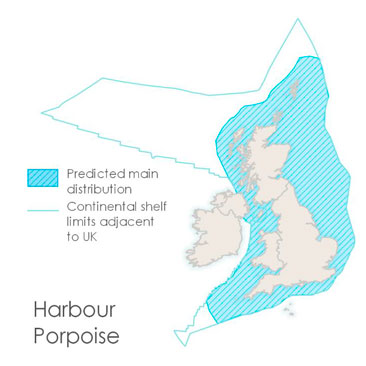
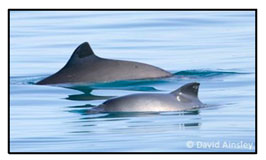
UK distribution – Densities tend to be highest in the southern North Sea and off the west coast of Scotland and in several areas in Celtic and Irish Seas. More recent data show that harbour porpoises are now more widely distributed throughout the English Channel than in previous decades.
Abundance and Trends – The most recent estimate of the abundance of harbour porpoises is 466,569 (95% Confidence interval = 345,306 - 630,417) in shelf waters extending from the coast of northern Norway south to southern Spain. This estimate excludes waters around Ireland which also contain considerable numbers of this species. Although there are two robust abundance estimates covering the UK EEZ over a period of 11 years, two data points do not enable confidence in population trends therefore the UK population trend is unknown. Estimates of abundance of harbour porpoise in the North Sea suggest that their numbers are stable (OSPAR IA, 2017[18]).
Long term population trend – Uncertain.
Common dolphin (Delphinus delphis)
31. Common dolphins are found in shelf and offshore waters where they can form large groups of thousands of individuals. Common dolphins feed on schooling fish (including cod, hake, mackerel, and herring) and are known to dive to 200 m. They are often associated with schools of other whales and dolphins, such as long-finned pilot whales.
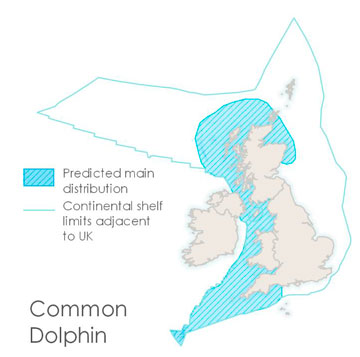
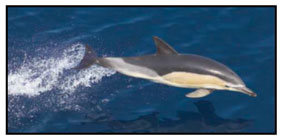
UK distribution – The UK is at the northern extent of the species' range in the Northeast Atlantic. Common dolphins are mainly found on the west coast of the UK, particularly off the South West.
Abundance and Trends - The most recent estimate of the abundance of common dolphins in northwest European waters is 467,673 (95% Confidence interval = 281,129 - 777,998). This estimate excludes waters around Ireland which also contain considerable numbers of this species. Although there are two robust abundance estimates covering the UK EEZ over a period of 11 years, two data points do not enable confidence in population trends therefore the UK population trend is unknown However, the abundance of this species estimated from the SCANS-III survey in 2016 was considerably higher than the previous survey in 2005.
Long term population trend – Unknown.
Atlantic white-sided dolphin (Lagenorhynchus acutus)
32. Atlantic white-sided dolphins can be found offshore in deep waters between 100 and 500 m, although they have also been seen in both shallower and deeper waters. They feed on a variety of marine fish, squid and crustaceans. The UK is towards the southern end of their distribution.
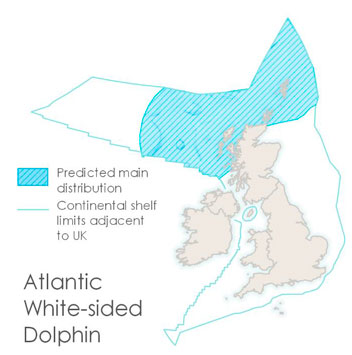
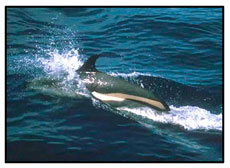
UK distribution – Atlantic white-sided dolphins are distributed primarily in the deep waters to the west and north of Scotland. Seasonal incursions onto the continental shelf occur but their density is much lower than that beyond the shelf edge.
Abundance and Trends - The most recent estimate of the abundance of Atlantic white-sided dolphins in northwest European waters is 15,510 (95% Confidence interval = 4,389 - 54,807). There is no information on trends.
Long term population trend – unknown
Bottlenose dolphin (Tursiops truncatus)
33. Bottlenose dolphins are found in coastal and continental shelf waters where they form distinct coastal and offshore populations. They have a diverse diet, including a variety of benthic and pelagic fish (both solitary and schooling species), squid and octopus. Bottlenose dolphins are known to attack other cetacean species including harbour porpoises.
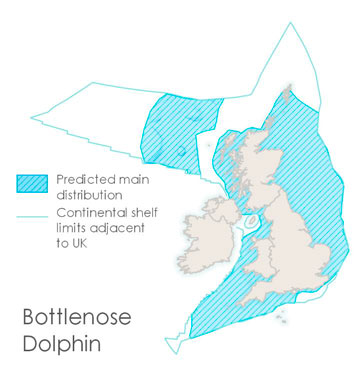
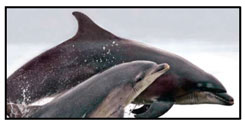
UK Distribution – There are two types of bottlenose dolphins; coastal and offshore. There are well-studied coastal populations along the east coast of Scotland and the west coast of Wales. The offshore population is widespread and has limited exchange with coastal populations, although their distributions may overlap.
Abundance and Trends - The most recent estimate of the abundance of bottlenose dolphins in northwest European waters is 27,697 (95% Confidence interval= 17,662-43,432). This estimate largely relates to offshore bottlenose dolphins but excludes waters around Ireland which also contain considerable numbers of this species. For the wider Cardigan Bay, Wales, the population of bottlenose dolphins is estimated at 150 to 246 individuals and is considered stable over the long-term. For the east Coast of Scotland the population is estimated at 155 to 216 individuals and is considered to be increasing. There is no information on trends in abundance for the offshore populations.
Long term population trend – Inshore populations are overall stable. Unknown for offshore populations.
White-beaked dolphin (Lagenorhynchus albirostris)
34. White-beaked dolphins are seen mainly in waters shallower than 200 m. They feed on small schooling pelagic fish (e.g. mackerel, herring, and sprat), haddock, as well as crustaceans, octopus and squid. White-beaked dolphins occur in the North Atlantic Ocean as far north as the Arctic pack ice and as far south as Portugal.
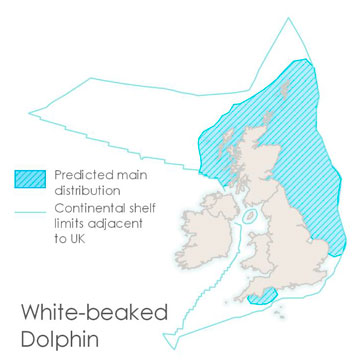
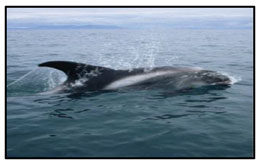
UK distribution – The species is most commonly found on the west coast of Scotland and in the North Sea. They are also relatively common off the Dorset and South Devon coasts.
Abundance and Trends - The most recent estimate of the abundance of white-beaked dolphins is 36,287 from a survey of northeast European waters (95% Confidence interval= 18,694-61,869). Although there are two robust abundance estimates covering the UK EEZ over a period of 11 years, two data points do not enable confidence in population trends therefore the UK population trend is unknown. In the North Sea, there is some evidence to suggest that there has been no change in abundance over the last two decades.
Long term population trend – Uncertain in the North Sea.
Risso's dolphin (Grampus griseus)
35. Risso's dolphins are seen in both shelf waters and deep waters between 400 and 1000 m. They are capable of diving for up to 30 minutes. They mostly travel in groups of 10 to 50 individuals but have been observed in groups of up to 4,000 animals. They are often seen associating with other cetaceans. Risso's dolphins feed on crustaceans, octopus and squid. There is evidence that the majority of foraging behaviour occurs at night. Risso's dolphins are widely distributed in both the northern and southern hemisphere.
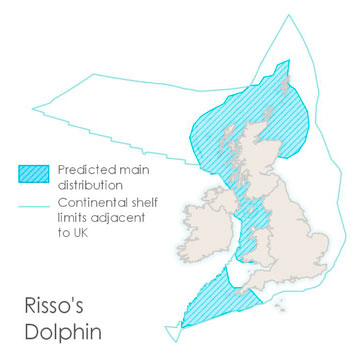
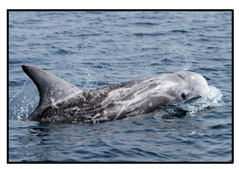
UK distribution – Risso's dolphins are widely distributed on the west and north coasts of the UK and around the Northern Isles.
Abundance and Trends – The most recent estimate of the abundance of Risso's dolphins is 13,584 in northeast European waters (95% Confidence interval= 5,943-31,047). There is no information on trends.
Long term population trend – unknown
Killer whale (Orcinus orca)
36. Worldwide, killer whales are known to live in stable family pods. Different pods have been known to develop different prey preferences and hunting strategies. They hunt co-operatively and many pods have distinct vocal dialects. Killer whales feed on a wide variety of prey species including marine mammals, seabirds, fish, octopus and squid. Killer whales seen around Shetland are known to switch feeding strategies from marine mammals to fish and back depending on the opportunities available. Some pods within this population are associated with the herring fishery, forming large groups during the autumn around the fishing fleet.
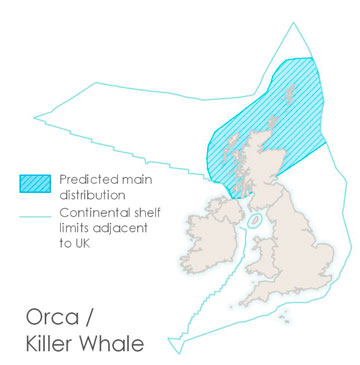
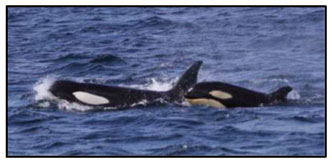
UK distribution – Killer whales occur around Shetland, Orkney and on the northwest coast of Scotland throughout the year. There are two distinct groups: a small population distributed primarily off the west of Scotland and a larger group of animals associated with the Icelandic population that are regularly seen around the Northern Isles and northern North Sea.
Abundance and Trends – In the UK, population estimates come from photo-identification studies. The group on the west coast of Scotland comprises eight individuals. There have been no recorded births in the group in the last two decades. Around 70 animals have been identified from the Northern Isles and wider east Scottish waters, but these are likely part of a much larger population of many thousands.
Long term population trend – unknown.
Long-finned pilot whale (Globicephala melas)
37. Long-finned pilot whales are usually found in deep waters (200 to 3,000 m) but will enter more coastal areas on a seasonal basis as they follow their prey inshore. Long-finned pilot whales are a deep-diving species, reaching depths of 600 m. They feed primarily on squid but also take a variety of fish species, particularly mackerel. There are two distinct populations; one found in the colder waters of the North Atlantic, and another in the southern hemisphere.
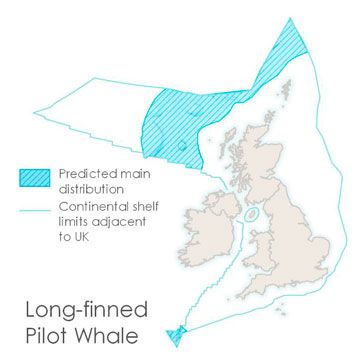
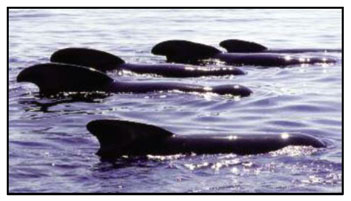
UK Distribution - Long-finned pilot whales are found off the continental shelf edge, mainly to the north of Scotland.
Abundance and Trends - The most recent estimate of the abundance of long-finned pilot whales in north eastern European waters is 25,777 (95% Confidence interval= 13,350-49,772). There is no information on trends.
Long term population trend – unknown
Minke whale (Balaenoptera acutorostrata)
38. 'Northern' or 'common' minke whales are widespread and seasonally abundant in northeast Atlantic waters for feeding during spring and summer. In the northeast Atlantic, and particularly in UK waters, sandeel forms the bulk of their diet, alongside herring, sprat, pout, whiting and mackerel. They are commonly recorded in shelf waters in depths of 200m or less, but are also known to be found in deeper waters beyond the continental shelf.
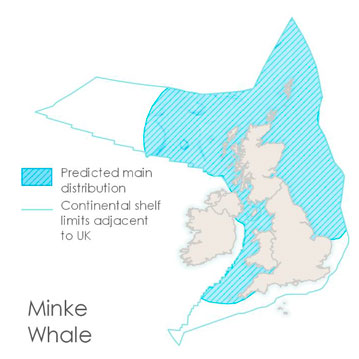
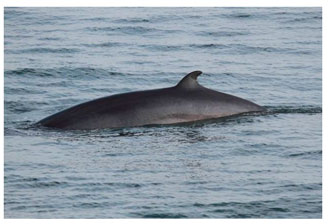
UK Distribution – Minke whales range widely and can be observed throughout UK waters, predominantly during spring and summer, although they are less common around the southern North Sea and English Channel.
Abundance and Trends - The most recent estimate of the abundance of minke whales in northwest European waters is 12,340 (95% Confidence interval = 6,912-22,032) which is approximately equal to the 2005-2007 estimate from previous surveys of 12,867 (95% Confidence interval = 5,507-30,062). Although there are two robust abundance estimates covering the UK EEZ over a period of 11 years, two data points do not enable confidence in population trends therefore the UK population trend is unknown. However, for the North Sea abundance is considered to be stable (OSPAR IA, 2017).
Long term UK population trend – unknown
Contact
Email: marine_conservation@gov.scot
There is a problem
Thanks for your feedback